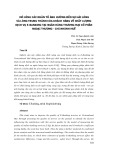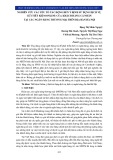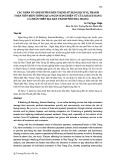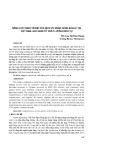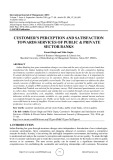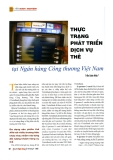
Nguyenetal. Future Business Journal 2024, 10(1):61
https://doi.org/10.1186/s43093-024-00354-0
RESEARCH
The impact ofservice innovation
oncustomer satisfaction andcustomer loyalty:
acase inVietnamese retail banks
Ha Minh Nguyen1,2,3, Trinh Kieu Thi Ho4 and Trung Thanh Ngo2,5*
Abstract
Customer loyalty continues to be a crucial factor for retail banks in maintaining market share, increasing revenue
and profits, and reducing costs in the highly competitive business landscape of today. They consistently strive
for innovation to maintain a competitive edge, introducing novel experiences and heightened satisfaction to custom‑
ers, thereby enhancing customer loyalty. This study aims to examine the effect of service innovation on customer
satisfaction and loyalty in the Vietnamese banking sector. The research investigates banking service innovation
from three angles: novel service concept, novel service procedure, and novel technological distribution system. To
confirm the relationship between concepts and complete the survey questionnaire, qualitative research techniques
are employed. Simultaneously, a quantitative research technique (structural equation modeling—SEM) is used
to assess the relationship between concepts. The study surveyed 398 clients of Vietnamese retail banks. All dimen‑
sions of service innovation, including novel service concept, novel service procedure, and novel technological distri‑
bution system, have positive effects on customer satisfaction and loyalty. Customer satisfaction also has a substantial
effect on customer loyalty. Finally, it then draws some conclusions and makes some recommendations to retail banks
to improve both customer satisfaction and customer loyalty via enhancing service innovation.
Keywords Novel service concept, Novel service procedure, Novel technological distribution system, Retail banking
sector
Introduction
Customer loyalty is a well-established and long-lasting
marketing and business idea. It has been the subject of
scholarly inquiry for many decades. Customer loyalty is
a vital component of a company’s profitability and opera-
tion. It is used in marketing to determine the relationship
between consumer preferences and product offerings
[10]. Customer loyalty has a substantial impact on profit
production. It may be described as the degree of correla-
tion between an individual’s recurrent patronage and the
grade of their relative attitude toward the business [98].
Furthermore, it is recognized as a holistic investment
that provides insight into the management of consumer-
service provider relationships across numerous indus-
tries [57].
Open Access
© The Author(s) 2024. Open Access This article is licensed under a Creative Commons Attribution 4.0 International License, which
permits use, sharing, adaptation, distribution and reproduction in any medium or format, as long as you give appropriate credit to the
original author(s) and the source, provide a link to the Creative Commons licence, and indicate if changes were made. The images or
other third party material in this article are included in the article’s Creative Commons licence, unless indicated otherwise in a credit line
to the material. If material is not included in the article’s Creative Commons licence and your intended use is not permitted by statutory
regulation or exceeds the permitted use, you will need to obtain permission directly from the copyright holder. To view a copy of this
licence, visit http:// creat iveco mmons. org/ licen ses/ by/4. 0/.
Future Business Journal
*Correspondence:
Trung Thanh Ngo
trung.nt@ou.edu.vn
1 Ho Chi Minh City Open University, 35‑37 Ho Hao Hon Street, District 1,
Ho Chi Minh City, Vietnam
2 Finance, Economic and Management Research Group (FEMRG), Ho Chi
Minh City Open University, 35‑37 Ho Hao Hon Street, District 1, Ho Chi
Minh City, Vietnam
3 Research Centre in Business, Economics, and Resources (CBER), Ho Chi
Minh City Open University, 35‑37 Ho Hao Hon Street, District 1, Ho Chi
Minh City, Vietnam
4 The Graduate School, Ho Chi Minh City Open University, 97 Vo Van Tan
Street, District 3, Ho Chi Minh City, Vietnam
5 Faculty of Finance and Banking, Ho Chi Minh City Open University, 35‑37
Ho Hao Hon Street, District 1, Ho Chi Minh City, Vietnam

Page 2 of 15
Nguyenetal. Future Business Journal 2024, 10(1):61
In many business contexts, customer satisfaction is
one of the crucial antecedents that positively influences
consumer loyalty. Many prior studies, including those by
Kassim and Asiah Abdullah [54], Pan etal. [75], Quach
etal. [76], Samudro etal. [81], Singh etal. [85], Zhang
et al. [104], have demonstrated this. The relationship
between customer satisfaction and customer loyalty in
the banking industry has also been the subject of exten-
sive research, with numerous findings indicating that the
two concepts are significantly related. Customer loyalty
is significantly influenced by satisfaction levels in the
retail banking industry in India [56] and in Vietnam [72].
Customer loyalty is significantly impacted by customer
satisfaction in the realm of electronic banking [9, 35].
Additionally, Albaity and Rahman [2] assert that satis-
fied customers are less likely to defect from their banks,
indicating that customer satisfaction and loyalty are
positively correlated. Similar findings regarding the rela-
tionship between customer loyalty and satisfaction were
obtained by Fida et al. [36], Tegambwage and Kasoga
[89], both of whom conducted research in the context of
Islamic banking.
In today’s competitive market, innovation is increas-
ingly viewed as a critical factor in determining a busi-
ness’s long-term success [11, 41], as businesses that can
innovate will be able to overcome environmental chal-
lenges more quickly and effectively than non-innovative
ones [15, 20], [67]. According to Rogers etal. [80], inno-
vation is defined as a new idea, practice, or object by an
individual or organization.
The role of innovation is crucial in enabling the sus-
tainable development of banks. In order to ensure the
retention of competitive advantage, the satisfaction of cli-
ent needs, and the encouragement of economic growth,
banks must prioritize their attention on innovation [63].
The aforementioned technology enables improved man-
agement of constraints, flexibility in adapting to changing
circumstances, and the capacity to suggest customized
offers that correspond to evolving needs [84]. Further-
more, a positive association has been shown between
innovation and knowledge management practices in the
banking industry. The aforementioned processes involve
the procurement, utilization, and retention of informa-
tion, all of which have a substantial impact on the culti-
vation of sustainable competitive advantage within the
banking industry [61].
In the 4.0 technology era, retail banks cannot afford
to ignore the use of technology to improve service dis-
tribution and operational efficiency. The integration of
innovation and technology in the banking industry has
significantly transformed the approach to delivering
products and services to customers [1]. In other words,
technological innovation is viewed as a key factor in
driving innovation in the retail banking sector. This can
be attributed to novel services. The emergence of these
new electronic channels has made banking services more
convenient to supply [50]. The banking sector experi-
ences notable effects on service delivery as a result of
technological innovation, leading to enhancements in
efficiency, customer service, and overall performance
[4]. Retail banks are obligated to maximize shareholder
returns and wealth. They can only achieve this desired
outcome through innovation. Innovation is very impor-
tant in the retail banking sector; there is a constant need
to adapt to changing client needs [68].
Despite widespread recognition of innovation’s impor-
tant role in a competitive environment, innovation is
not without its challenges [27]. These challenges for the
retail banking industry include recurring system failures,
network problems, automated teller machine (ATM)
malfunctions, and so on, which lead to customer churn,
dissatisfaction, and disloyalty with service providers.
Customers’ influence in retail banks’ businesses is grow-
ing as a result of mobile technology and social networks.
Good business is not enough; it is also necessary to pro-
vide customers with values other than the core value.
Retail banks are increasingly carrying more and more
responsibilities. Banking services innovation comprises
technologies, service concepts, delivery systems, and cli-
ent interfaces, all of which result in novel consumer expe-
riences and service utilization [91]. So, these institutions
must consequently identify the necessary innovations to
distribute services to their customers successfully, as well
as devise methods and strategies for effectively manag-
ing these innovations to achieve the desired goal. When
a business gains a competitive advantage and grows, it
fosters customer loyalty, which is critical to the success
of all organizations, as acquiring new consumers is more
costly and time-consuming than keeping existing ones
[90]. Businesses that develop and retain client loyalty
might obtain larger profit margins throughout the life of
the client relationships [95]. As a result, the objective of
this research undertaking is to investigate the influence
of service innovation on customer loyalty and satisfac-
tion within the retail banking industry in Vietnam. The
experimental findings are utilized to formulate recom-
mendations pertaining to service innovation with the aim
of enhancing consumer loyalty and satisfaction.
Literature review
Customer loyalty
Customer loyalty can be determined by behavioral and
attitude factors. Customers’ attitudes encompass con-
cepts such as their intention to repurchase or purchase
more products from a specific provider, their intention
to suggest the product to many different consumers, and

Page 3 of 15
Nguyenetal. Future Business Journal 2024, 10(1):61
their demonstrated adherence to the supplier through
their refusal to switch to other competitors or their will-
ingness to pay high prices [21]. In addition, consumer
loyalty can be described as the customer’s disposition
regarding the likelihood of repurchasing identical prod-
ucts [49]. Customer loyalty is behaviorally described as
the repeated purchase of a variety of items from a sin-
gle vendor, the willingness to refer the provider to vari-
ous clients, and a long-term perception of the brand as a
viable option.
As these, customer loyalty refers to an intended or
real behavior toward a supplier. Customer loyalty can
be viewed as vital to the continued success of a corpora-
tion [58]. Loyal clients are unconcerned about additional
fees within a fair range, speak more favorably about the
company, and ignore competing businesses [87, 88].
Customer loyalty is one of a business’s most critical and
essential assets. When a supplier establishes and retains
client loyalty, the connection between the supplier and
the customer is a win–win situation [75]. According
to Oliver [73], customer loyalty is the firm assurance of
future repurchases of preferred products. Loyal consum-
ers are unaffected by unfavorable procurement situations
or other suppliers’ efforts to promote supplier switching.
Consequently, churn barrier construction expenses will
be reduced, and the organization’s revenue will exhibit
greater stability and facilitate growth. The impact of cus-
tomer loyalty on long-term financial performance and
the accomplishment of organizational goals serves to
highlight its significance [55]. It is regarded as a critical
component of organizational effectiveness [70].
Customer satisfaction
The concept of customer satisfaction is complex and
has been the subject of extensive research across vari-
ous domains. The concept is frequently defined as the
degree to which post-purchase perceptions of a service
or product align with its actual characteristics. Customer
satisfaction is the emotional reaction of a customer when
their evaluation of a product or service matches their
initial expectations [40, 45], [65]. Customers feel satis-
fied when they perceive that the product or service ful-
fills their desires and expectations [13]. The gap between
anticipated and actual outcomes is the metric utilized in
the traditional satisfaction model to assess customer sat-
isfaction [51].
Satisfaction is defined by Hesselink etal. [48] as a posi-
tive state that impacts assessments of every aspect of
multilateral cooperation. A primary concern for organi-
zations is the establishment and sustenance of a com-
petitive edge [17]; additionally, the perception of the
product among the general public following customer
usage is crucial [18]. Consequently, customer satisfaction
has attained an all-encompassing status, given that the
majority of businesses consider their customers to be
their primary revenue generators.
Customer satisfaction is a dynamic concept that is
influenced by a multitude of environmental and tempo-
ral factors [64], [105]. Customer satisfaction with bank-
ing service refers to the degree to which customers are
content with their overall encounter at a bank branch,
encompassing service procedures and waiting time
[74]. According to Anderson etal. [6], Briggs etal. [14],
Deng etal. [26], price fairness, service quality, and per-
formance-based satisfaction are the determinants of the
aforementioned comparison. Furthermore, it exhibits a
strong correlation with customer engagement, satisfac-
tion, and the fulfillment of basic human requirements
[29], [100]. Customer satisfaction is a critical determi-
nant of business performance, profitability, and share-
holder value within the service industry [23, 78].
Service innovation
According to Schumpeter [82], the concept is defined as a
novel approach or a unique mix of production elements.
Damanpour [22] defines innovation as a total or par-
tial change in a firm’s structure, operations, and outputs
that allow integration with the outer world. Damanpour
emphasizes that innovation must be integrative, regard-
less of where it comes from, it would be fully incorpo-
rated into the context, since this determines customer
acceptance and use. Furthermore, innovation must have
a positive environmental impact, introducing a socially
responsible aspect to the innovation process. Elçi [30],
like Damanpour [22], emphasizes innovation as a con-
tinuous process and defines it as continuous change and
differentiation in products, services, and work methods.
Elçi [30] asserts that innovation must be helpful to both
the economy and society since it is the result of the fusion
between social and technological processes.
The multidimensional and interactive view of service
innovation resulted in Den Hertog [24]’s six-dimensional
conceptual model. This six-dimensional model is derived
from the explanations provided by scholars such as Den
Hertog and Bilderbeek [25], Hertog [47], Van Ark etal.
[93]. The model denotes various service-related innova-
tions in six distinct dimensions, as follows:
New service concept The most widely recognized aspect
of service innovation is the novel service concept [7, 47].
According to Frei [37], novel service concepts are also
referred to as providing additional services, they combine
elements of one service with a portion of another service
to create a new service or policy. This aspect could be a
plan or a solution for how management previously failed
at an organization and is now looking to incorporate

Page 4 of 15
Nguyenetal. Future Business Journal 2024, 10(1):61
additional services to apply in the organization’s current
context [94].
New customer interaction This element refers to
changes in client interaction methods during the ser-
vice’s conception, manufacturing, distribution, and con-
sumption. This dimension, according to Hertog [47],
emphasizes the participatory role of the client because
innovation can stem from how a service organization
interacts with the user. Martin and Horne [66] believe
that a major success component in the process of devel-
oping novel services is the new customer interaction
aspect.
New business partner It is a shift in how a service is cre-
ated, such as collaborative implementation with a part-
ner. Service innovation may necessitate collaboration
with partner organizations in addition to co-production
and co-creation with customers. Thus, collaborative
development and collaborative production are consid-
ered a shift in the overall output of a service, akin to a
structural upgrade in the value chain.
New revenue model This dimension is related to the
contention that some service innovations are only con-
cerned with new costing or revenue generation strat-
egies. A service enhancement, whether it is a unique
combination of current service elements or a novel ser-
vice pack, frequently demands an acceptable model of
price and cost allocation considerations so that custom-
ers recognize and are ready to pay for the extra value of
the service.
New service distribution system (organizational com-
ponent) This dimension is concerned with the human
component of the distribution system, which includes
personnel, organizational structure, and culture. In other
words, it involves the supplier-purchaser relationship.
The new distribution system component is particularly
relevant to the change in the internal structure of the
organization in order to promote change in the way ser-
vices are given [7, 38, 47]. When other components of
service innovation are modified, the organization and
its service distribution system are frequently updated to
allow these changes to take place, as new services may
need a different organizational structure as well as the
skills and potential mix of personnel involved.
New service distribution system (technological compo-
nent) This dimension focuses on the technological sys-
tems and processes involved in service distribution. The
development of information and communication tech-
nologies is opening up enormous possibilities for the
introduction of new service concepts, new ways of inter-
acting with customers and other partners, the develop-
ment of new revenue models, and the establishment of
new service distribution systems. New technological ser-
vice distribution systems will stimulate and/or necessitate
new innovations in one or more of the other dimensions,
and vice versa [24].
Customers are less likely to recognize the new busi-
ness partner aspect because it is not publicly declared by
the company and is not clearly visible to them. In con-
trast, the remaining five dimensions, which include “new
service concept,” “new customer interaction,” “new rev-
enue model,” “new service distribution system (organi-
zational component),” and “new service distribution
system (technological component),” are all properly seen
by customers as innovation outcomes. As a result, these
five factors are commonly utilized as indicators to assess
customers’ impressions of the supplier’s service innova-
tion. According to Mahmoud etal. [62], there are paral-
lels between some of the aforementioned components,
thus, they combine the “new service concept” and “new
revenue model” into the “novel service concept” aspect
and the “new customer interaction” and “new service dis-
tribution system (organizational component)” into the
“novel service procedure” aspect. The last dimension is
renamed from “new service distribution system (techno-
logical component)” to “novel technological distribution
system.” Tonui etal. [91] assert that servicing concepts,
delivery systems, client interfaces, and technologies are
all components of banking service innovation, which
generates novel customer experiences and product uti-
lization. Hence, drawing inspiration from the studies
of Mahmoud etal. [62] as well as Tonui etal. [91], this
research investigates three facets of banking service inno-
vation: novel service concept, novel service procedure,
and novel technological distribution system.
The relationships betweenconcepts
The impacts ofservice innovation oncustomer satisfaction
The primary goal of innovation is to enhance services and
products in order to delight customers, boost productiv-
ity, lower costs, and create new opportunities [39]. When
new products or services are put into the market, they
have an effect on consumers’ views of their potential to
meet their requirements [60]. When customers are sat-
isfied, they prefer to purchase more, and their favorable
feedback readily and inexpensively attracts new custom-
ers. It is critical to invest in innovation since it enables
businesses to satisfy customers [42, 43]. Service innova-
tion is basically a corporate strategy for developing new
products or increasing the value of existing services to
meet customers’ demands. As a consequence, it is vital to
confront the issues given by consumers, and at this point,
the major innovation capability is to increase customer
contact in the service delivery system or technology [52,
60]. Service innovation reflects market advantages and
assists businesses in establishing long-term connections
with customers and providing them with high-quality

Page 5 of 15
Nguyenetal. Future Business Journal 2024, 10(1):61
products and services [28]. According to the findings of
Biswas etal. [12], Kanwal and Yousaf [52], YuSheng and
Ibrahim [103], there is a positive association between ser-
vice innovation and customer satisfaction, and customers
are better satisfied when they perceive more innovation.
Yeh etal. [101], Chuang and Hsu [19], Tsai etal. [92] all
discovered the relation between service innovation and
customer satisfaction. As a result, the following hypoth-
esis was formulated regarding the relationship between
service innovation and customer satisfaction:
H1a There is a positive relationship between the novel
service concept of service innovation and customer
satisfaction.
H1b There is a positive relationship between the novel
service procedure of service innovation and customer
satisfaction.
H1c There is a positive relationship between the novel
technological distribution system of service innovation
and customer satisfaction.
The impacts ofservice innovation oncustomer loyalty
Customer loyalty is impacted by the customer’s evalua-
tion of the outcomes obtained from interactions with
the service provider, which is alternatively referred to
as service output quality [34]. Customers are unlikely
to transfer to an alternative brand if the current brand
offers superior products with higher output quality that
more effectively fulfill their needs. Customer loyalty is
positively impacted by service quality [96]. Outdated
technologies and approaches are incapable of fulfill-
ing forthcoming demands. Hence, for sustained growth,
an organization must try to introduce innovative ser-
vices and enhance customer benefits with the intention
of fostering customer loyalty [52]. Customers remain
loyal to a business exclusively when it introduces novel
products and services that align with changing market
trends or meet new demands of customers. As a result,
service innovation is regarded as a critical component in
the pursuit of consumer loyalty. In the absence of inno-
vative products or services, consumers have a tendency
to transition to alternative brands that possess more dis-
tinctive attributes [39]. Awuku etal. [8] present empirical
support for the notion that service innovation has a sub-
stantial and positive effect on customer loyalty within the
telecommunications sector. Furthermore, the loyalty of
consumers who utilize e-commerce services is positively
impacted by service innovation [77].
Ameme and Wireko [5], Musara and Fatoki [69], Nanda
etal. [71], Rashid etal. [79], YuSheng and Ibrahim [103]
are among the few scholars who have compiled empiri-
cal evidence on the effect of service innovation on cus-
tomer loyalty in the retail banking sector of emerging
countries. Ameme and Wireko [5] recognize the cor-
relation between customer loyalty and technological
innovation; however, they caution that the introduction
of such innovations in the banking sector incurs substan-
tial transaction costs and presents numerous drawbacks
for customers. Technological innovation, according to
Musara and Fatoki [69], is crucial for increasing bank-
ing efficiency and decreasing transaction costs for bank-
ing customers. The significance of service innovation
in impacting consumer loyalty toward bank-provided
services is further demonstrated in studies by YuSheng
and Ibrahim [103] and Rashid etal. [79]. Concerning the
effect of service innovation on consumer loyalty, the sub-
sequent hypotheses are formulated:
H2a There is a positive relationship between the novel
service concept of service innovation and customer
loyalty.
H2b There is a positive relationship between the novel
service procedure of service innovation and customer
loyalty.
H2c There is a positive relationship between the novel
technological distribution system of service innovation
and customer loyalty.
The impacts ofcustomer satisfaction oncustomer loyalty
Customer satisfaction is an antecedent of customer loy-
alty. A wide range of empirical research findings provide
support for this assertion. According to the research of
Kassim and Asiah Abdullah [54], customer satisfaction
influences both trust and loyalty in the e-commerce envi-
ronment. Regarding electronic banking services, Zhang
etal. [104] concur that customer satisfaction plays a cru-
cial role in fostering loyalty. Additional empirical investi-
gations have examined the positive correlation between
customer satisfaction and loyalty within the banking
industry. These studies include those by Albaity and Rah-
man [2], Ayinaddis etal. [9], Esmaeili etal. [35], Fida etal.
[36], Kaura etal. [56], Nguyen etal. [72], Tegambwage
and Kasoga [89]. In Islamic banking, customer satisfac-
tion is additionally identified as an antecedent to cus-
tomer loyalty [89].
Numerous empirical studies conducted in the broader
research context, including those by Carolina and
Yasa [16], Samudro et al. [81], Singh et al. [85], Yang
and Peterson [99], confirm that customer satisfaction
affects customer loyalty. The significance of customer




